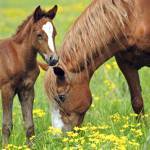Is Fit or Fat Best for Breeding Mares?

Environmental and physiological stresses will affect the body condition of mares as breeding season nears. Competition for food by herdmates or scarcity of feed in winter may lead to thinness. Moreover, lactation can easily deplete energy stores of mares, leaving them with reduced body condition and breeding efficiency.
Though every mare should be managed individually with her specific needs in mind, a few general recommendations can be made.
Maintain open or maiden mares at a body condition score of 5 or 6 leading up to the breeding season. For pregnant mares that will be lactating in late winter or spring, a condition score of 6 or 6.5 is ideal. Keeping mares at condition scores higher than 6.5 does not enhance fertility and is not wise from an economic standpoint.
Evaluating the body condition of pregnant mares may become more difficult during late gestation, as the combined weight of the fetus and amniotic fluid may pull the skin tightly over the vertebral column and ribcage. Therefore, it’s best to place emphasis on other key areas: along the withers, behind the shoulder, and around the tailhead.
Do not rely completely on visual appraisal to assess body condition. By palpating certain areas, evaluators can more accurately judge body condition. For example, ribs that are not visible may or may not be felt easily. Palpation is particularly important in winter when mares likely have winter coats. If possible, have the same person evaluate condition on a monthly schedule, as this will ensure a degree of consistency.
Read more:








